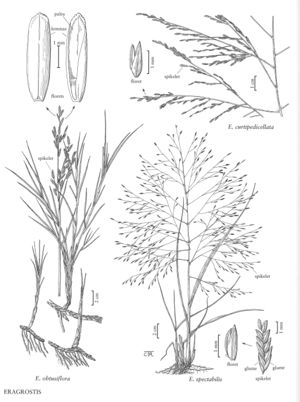Difference between revisions of "Eragrostis curtipedicellata"
FNA>Volume Importer |
FNA>Volume Importer |
||
| Line 17: | Line 17: | ||
-->{{Treatment/Body | -->{{Treatment/Body | ||
|distribution=Kans.;Okla.;Colo.;N.Mex.;Tex.;La.;Mo.;Ark. | |distribution=Kans.;Okla.;Colo.;N.Mex.;Tex.;La.;Mo.;Ark. | ||
| − | |discussion=<p>The range of Eragrostis curtipedicellata extends from southern Colorado, Kansas, and Missouri to northeast¬ern Mexico. It grows near fields, along roadsides, and in the margins of woods, at 10-1525 m.</p> | + | |discussion=<p>The range of <i>Eragrostis curtipedicellata</i> extends from southern Colorado, Kansas, and Missouri to northeast¬ern Mexico. It grows near fields, along roadsides, and in the margins of woods, at 10-1525 m.</p> |
|tables= | |tables= | ||
|references= | |references= | ||
| Line 26: | Line 26: | ||
-->{{#Taxon: | -->{{#Taxon: | ||
name=Eragrostis curtipedicellata | name=Eragrostis curtipedicellata | ||
| − | |||
|authority=Buckley | |authority=Buckley | ||
|rank=species | |rank=species | ||
| Line 33: | Line 32: | ||
|basionyms= | |basionyms= | ||
|family=Poaceae | |family=Poaceae | ||
| − | |illustrator=Linda A. Vorobik | + | |illustrator=Linda A. Vorobik;Cindy Roché |
| + | |illustration copyright=Utah State University | ||
|distribution=Kans.;Okla.;Colo.;N.Mex.;Tex.;La.;Mo.;Ark. | |distribution=Kans.;Okla.;Colo.;N.Mex.;Tex.;La.;Mo.;Ark. | ||
|reference=None | |reference=None | ||
| Line 39: | Line 39: | ||
|publication year= | |publication year= | ||
|special status= | |special status= | ||
| − | |source xml=https:// | + | |source xml=https://jpend@bitbucket.org/aafc-mbb/fna-data-curation.git/src/f50eec43f223ca0e34566be0b046453a0960e173/coarse_grained_fna_xml/V25/V25_145.xml |
|subfamily=Poaceae subfam. Chloridoideae | |subfamily=Poaceae subfam. Chloridoideae | ||
|tribe=Poaceae tribe Cynodonteae | |tribe=Poaceae tribe Cynodonteae | ||
Revision as of 20:33, 16 December 2019
Plants perennial; cespitose, with innovations and short, knotty rhizomes less than 4 mm thick. Culms 20-65 cm, erect, viscid. Sheaths usually viscid, hairy at the apices and on the collars and margins, hairs to 6 mm; ligules 0.1-0.3 mm; blades 5-18 cm long, 2-4(5) mm wide, flat to involute, sometimes viscid, densely hairy behind the ligules, hairs to 8 mm. Panicles 18-35 cm long, 10-30 cm wide, broadly ovate, open; primary branches 3-18 cm, diverging 10-90° from the rachises, stiff, viscid, naked basally; pulvini hairy, hairs to 6 mm; pedicels 0.2-1.2 mm, appressed. Spikelets 3.5-6(7.6) mm long, 1-1.5 mm wide, linear-lanceolate, stramineous to reddish-purple, with 4-10 florets; disarticulation basipetal, glumes persistent. Glumes lanceolate, membranous; lower glumes 0.9-1.8 mm; upper glumes 1.2-2 mm, 1-3-veined; lemmas 1.5-2.2 mm, ovate to lanceolate, membranous, 3-veined, lateral veins evident, apices acute; paleas 1.2-2 mm, hyaline, not wider than the lemmas, apices obtuse; anthers 3, 0.2-0.4 mm, purplish. Caryopses 0.6-0.8 mm, ellipsoid, terete in cross section, neither ridged nor grooved, faintly striate, reddish-brown. 2n = 40.
Distribution
Kans., Okla., Colo., N.Mex., Tex., La., Mo., Ark.
Discussion
The range of Eragrostis curtipedicellata extends from southern Colorado, Kansas, and Missouri to northeast¬ern Mexico. It grows near fields, along roadsides, and in the margins of woods, at 10-1525 m.
Selected References
None.
